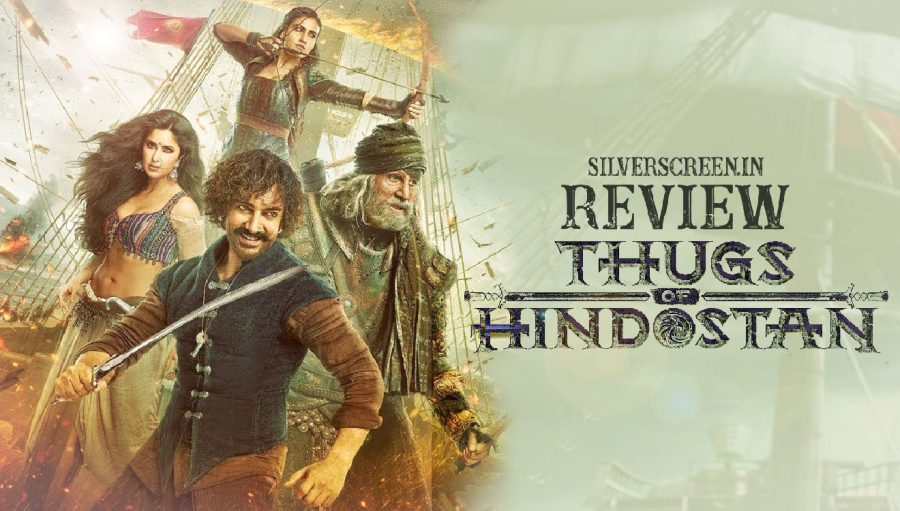Director: Vijay Krishna Acharya
Cast: Amitabh Bachchan, Aamir Khan, Fatima Sana Sheikh, Katrina Kaif
Composer: Ajay-Atul, John Stewart
That Thugs Of Hindostan, a giant budget multi-starrer, comes at a time when Bollywood is exploding with breakout hits like Badhaai Ho and Stree is an interesting irony. Contrary to the latter films that are shouldered entirely by intelligent screenplay and an ensemble cast, Thugs… uses an enormous amount of mainstream Hindi cinema cliches that the audience have a love-hate relationship with. The highlight of the film isn’t a groundbreaking story or the style of narration, but the fact that it brings to the table two of India’s biggest stars – Amitabh Bachchan and Aamir Khan. Following the recent trend in the industry, it poses as a tale of patriotism which backfires severely.
Everything about it looks densely mediocre. Yet, surprisingly enough, the film manages to strike a few right notes in some places, and salvages itself from being an utterly unwatchable mess. To begin with, Thugs of Hindostan isn’t obviously designed to be great cinema, but an unabashed potboiler that plays to the galleries. It operates in a fantasy world where the British men speak better Hindi than the locals, and an eagle is smarter than most of the human beings. Although the film runs on a harebrained story-line, the punch moments, especially those involving Bachchan, are impressively choreographed, backed by delectable music scored by Ajay-Atul and John Stewart Eduri. The film wears inanity on its sleeve, but turns it into a selling point. The production design is whimsical rather than based on period research, and plot points are triggered by melodramatic moments.
The climatic showdown happens over a song sequence that could crack up (unintentionally though) even the ardent fans of Bollywood cinema. Khan plays his role animatedly, like a parody of Pirates Of The Caribbean’s Jack Sparrow, riding on a donkey named Nawab. His buffoonery waters down the film’s dreary moments, and turns it into a one-man-show of sorts. And there is Katrina Kaif, the diva, playing a dancer named Suraiyya, entrusted with the task of seducing the British men in two dance numbers.
Directed by Vijay Krishna Acharya, it is a ‘period drama’ set in the late 18th century, in a fictional terrain somewhere along the West coast of India. There are forts, palaces and sword fights, over-dressed kings and pirates, and the East India Company who, naturally, are the antagonists. The Company has made inroads to every kingdom in the Indian subcontinent, enslaving the rulers and looting the wealth of the land. To take them on, a rebel group gathers under the leadership of a lionhearted warrior, Khudabakh (Bachchan) who goes by the name Azaad, and his valiant foster daughter Zafira (Fatima Sana Sheikh). And to rein them in, the British hires a conman, Firangi Mallah (Aamir Khan) who believes it is more important to be alive than to be good or bad.
It is easy to see why Mr Acharya, who previously made Dhoom 3, was entrusted with directing this film. Although there are at least two centuries between Thugs… and the Dhoom franchise, they have a lot in common. The plot has an enormous number of ‘twists’ and double-crossing instances. The two female actors – Fatima Sana Sheikh and Katrina Kaif – in spite of the brave-heart faces they put up, are ultimately eye-candies. It wasn’t an accident that the ladies didn’t have a single line to utter in the trailer. Sheikh has great body-language. Her Zafira is a belligerent fighter. But she is always a sidekick and never the leader. At least twice in the film, she is talked about as a responsibility – a precious little gift that needs to be guarded and saved from foreign attackers. Kaif looks ethereal and daring, and her dance isn’t like anything we have seen before – it is strange, more mechanical than human, perhaps denoting how clerical our life and perception of art has become since the time of danseuses like Sridevi and Madhuri Dixit.
Recommended
Every now and then, someone in the frame takes the word, ‘azaadi [freedom]’, to stress that this isn’t just a mindless film, but one that serves a bigger interest. The film fiddles with the word like a bad poet, clueless about what to make of it. At the end of it all, no great freedom is won. In a different era, the film might have taken a far lighter word to latch itself onto. The British as villains is one of Indian mainstream cinema’s laziest short-hands for a period drama. The makers of Baahubali had to spend a huge flashback sequence (or call it an entire movie) to etch out the evilness of Bhallaladeva. The screenplay invested in great moments of tension between him and his brother, and the many tiny instances of rivalry that lead to the final battle. Here, the film assumes that the British officer’s villainy needs no explanation. So he, like most of the characters in the film, isn’t fleshed out adequately to be even slightly memorable.
If there is one sure takeaway from Thugs Of Hindostan, it’s the lesson in filmmaking that no amount of money or no number of stars can make up for the lack of intelligent writing.
*****
The Thugs Of Hindostan review is a Silverscreen original review. It was not paid for or commissioned by anyone associated with the film. Silverscreen.in and its writers do not have any commercial relationship with movies that are reviewed on the site.



